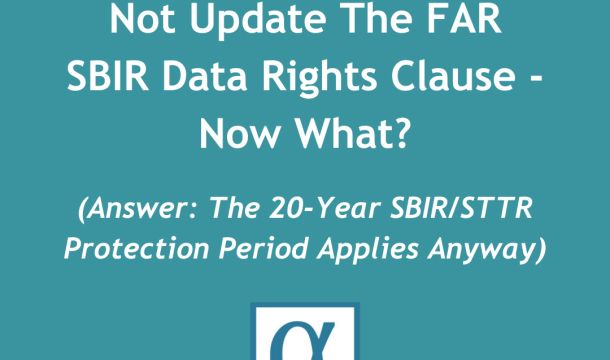The GovCon Bulletin™
Distributed Solutions, Inc. v. James: Government Contract Software Developers Take Note
Last month, Distributed Solutions, Inc. (DSI) petitioned the U.S. Supreme Court to overturn a decision by the Armed Services Board of Contract Appeals (ASBCA) that was affirmed by the U.S. Court of Appeals for the Federal Circuit. The case involves software licensing rights under a federal government contract and serves as a reminder that FAR and DFARS clauses allocating data and software rights between federal agencies and contractors are not required to be inserted into all government contracts.
Last November, we issued a paper that provides an overview of the rules under FAR and DFARS that apply to inventions, software, and data. The paper also discusses the various FAR and DFARS clauses that are required to be inserted into government contracts and that allocate intellectual property rights between contractors and government agencies. However, although FAR 52.227-19 outlines certain of the government’s rights to use, modify and copy commercial computer software, neither FAR nor DFARS otherwise specifies particular intellectual property rights clauses that are required to be inserted into contracts for commercial data or commercial software, including software items on GSA schedule contracts. Consequently, the nature, extent and duration of licensing rights are left largely to the parties to negotiate.
The Distributed Solutions case, indeed, underscores the importance of clear and specific provisions that delineate rights to intellectual property in instances in which standard FAR and DFARS clauses are not required to be inserted into a contract.
In that case, DSI acquired ownership of software that, years earlier, was developed and delivered by the original software owner to the U.S. Department of the Air Force under a government contract. The ASBCA’s decision does not specify the particular type of government contract under which the software was delivered but does state that the contract did not include any intellectual property rights provisions or royalty provisions at the time of award. Thus, presumably the contract was not the type to which the FAR and DFARS clauses are required to be inserted. The government contract, in any event, was modified before DSI acquired ownership of the software to include an intellectual property rights clause that gave Air Force “continuous” rights to the software.
Eventually, DSI acquired ownership of the software through an asset purchase agreement and assumed obligations under the government contract with Air Force by entering into a novation agreement with the software company owner. The government contract with Air Force was subsequently modified to incorporate the novation agreement and then modified again to extend the period of performance and add certain maintenance requirements. Later, DSI’s work with Air Force related to the software was folded into a delivery order under an existing GSA schedule contract that DSI held. The delivery order was modified to include an intellectual property rights clause.
In the litigation, Air Force maintained that the contract modification providing for “continuous” rights to the software gave it a perpetual license, which was preserved in subsequent agreements with DSI. DSI, on the other hand, argued that the contract modification did not provide Air Force a perpetual license and, alternatively, even if it did, those rights were extinguished by subsequent modifications and the GSA schedule contract. DSI insisted that Air Force was required to pay it for its continued use of the software, but the ASBCA ultimately sided with the Air Force and the ASBCA’s decision was affirmed by the U.S. Court of Appeals for the Federal Circuit.
As the Distributed Solutions case demonstrates, issues over the extent and nature of the government’s licensing rights, which are addressed explicitly and implicitly in DFARS and FARS clauses, can easily be overlooked or become the source of misunderstanding in instances in which FARS and DFARS data and software rights clauses do not apply. The following are three takeaways for government contractors from the ASBCA decision, which can be downloaded here.
Three Takeaways
(1) Speak candidly. Have frank discussions with contracting officers over limits on the government’s use of software and technology and, when possible, document those communications.
(2) Distinguish contract deliverables from use rights. Distinguish the government’s rights to contract deliverables such as software development, software maintenance and upgrades from the government’s license rights to continued use of the software, either as delivered or as may be modified by the government, after the term of the contract ends. When applicable, price these items separately in contracts and proposals.
(3) Lay out your cards. In the words of the ASBCA, “put your cards on the table,” with regard to limitations on the government’s rights. Provisions that extinguish the government’s rights should say so clearly and explicitly.



